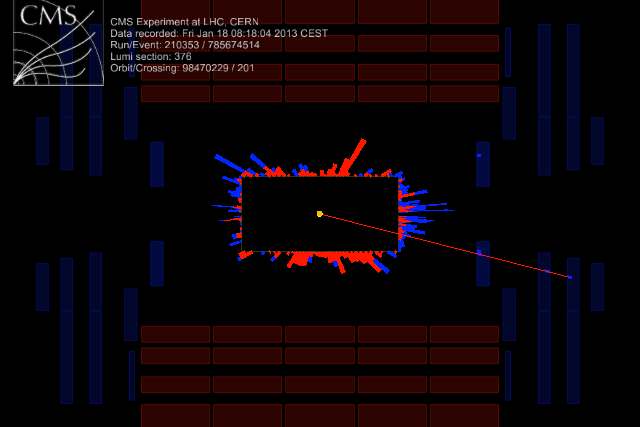
The new year brings a new type of collision at the LHC: the accelerator will smash protons and lead nuclei together, allowing CMS and the other LHC experiments to study the cold nuclear matter we expect these collisions to produce. Although we caught a glimpse of these asymmetric proton-lead (pPb) collisions during a pilot run last September, the next four weeks will bring the first sustained pPb run and provide valuable data. Indeed the small data sample from 2012 already revealed interesting phenomena, and raised interest in this study.
Preparing the detector
CMS preparations for collisions have been progressing steadily. “We have been commissioning the detector for operations as we recover from the three weeks of downtime during the Christmas shutdown,” points out Christof Roland, co-convener of the CMS Heavy-Ions (HI) group. Commissioning involves making sure all of the subdetectors of CMS are operating within their expected parameters.
“Work on recommissioning the detector started on 4 January, during the Christmas break,” says Maria Chamizo-Llatas, CMS Run Coordinator. “On 7 January, when everyone returned to CERN, we had cooling and power up and running. By that night, we were already taking cosmic data with all subdetectors except the Muon RPCs.”
“Compared to lead-lead collisions,” adds Christof, “you’re looking at different physics at different beam intensities. So you need dedicated trigger menus. This was where the biggest effort went in from the HI group: to prepare studies of all the triggers for the proton-lead run.” When colliding lead nuclei, there are around 4000 interactions each second, of which around 200 are recorded to tape. The proton-lead collisions, on the other hand, will have around 2,000,000 interactions each second, and CMS will record around 1000 of these. “For all these trigger studies,” explains Christof, “the pilot run in September was extremely useful to get an idea of what the rates would be so we could optimise everything.”
Since the collision rate in the pPb run is lower than that in the pp one, two forward subdetectors that couldn’t withstand the radiation under the harsher conditions of proton collisions have been reinstalled in CMS: CASTOR and ZDC. These subdetectors will help measure the collision remnants that travel very close to the beampipe, crucial to the study of pPb data.
Joining hands with TOTEM
For this run, CMS will combine forces with TOTEM so as to cover a greater range of collision data. The two are essentially separate entities — independent experiments that use different analysis software — and they are fully complementary. CMS measures in the central region and TOTEM exclusively measures in the very forward region. “Combining information from both allows us to do a lot of physics studies that previously were impossible to do,” says Christof. “You can correlate proton remnants seen in TOTEM with objects such as jets and Upsilon (Υ) particles observed in the central part of CMS.”
“We are going to use the TOTEM triggers,” says Maria. “We made some tests previously, including in the pilot pPb run last year. We had the TOTEM triggers going to CMS and vice versa.”
“The only point where we can synchronise between CMS and TOTEM is at the first level of the trigger system,” states Christof. “Then we know we have common triggers and each side stores the information of each trigger in the data stream. Later, you have to synchronise and pick the events that are common in both data sets. This is not a trivial operation,” he laughs, “but based on the pilot proton-lead run where we combined triggers, we have proved that it is possible. The first hours of collisions will be spent commissioning this operation.”
Physics aims of the pPb run
Julia Velkovska, also a co-convener of the HI group, explains the motivations behind colliding these different particle species together: “Not only does it act as a straight reference for lead collisions, but it is an interesting physics system in its own right. In addition, there are a lot of things that we think we can address now that weren’t on the cards a few months ago: the ridge we observed in the pilot run raised a lot of new questions and new approaches on how to analyse the data have been proposed.”
Now, if this ridge in pPb collisions is caused by the same effect as in PbPb collisions, you might also hope to see other phenomena only observed so far in PbPb data, such as quenching of jets.
What about other theoretical predictions, though? “That’s the fun of heavy-ion physics!” exclaims Christof. “These many-body systems and extended systems are very hard to calculate on a theoretical basis, so the experimental side is usually ahead of what the theory guys can calculate. That’s what makes this field also so exciting, because it’s really the experimental side to a large extent that drives the progress and understanding.”
The LHC is expected to commence the run over the weekend. “On the CMS side, we are ready for collisions!” says Maria with a smile.
[Note about all event displays: The red and blue boxes show energy deposits from particles produced in the collisions in the electromagnetic and hadronic calorimeters, respectively. As the inner tracker was not activated during this run, charged particles could not be reconstructed as charged tracks.]
- Log in to post comments

